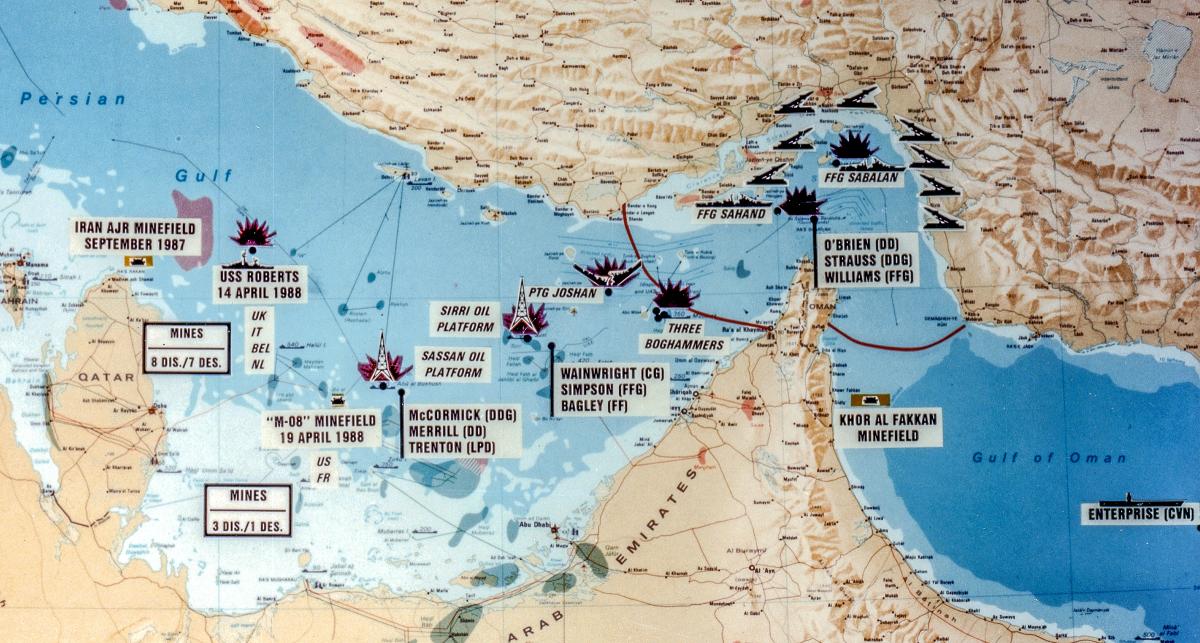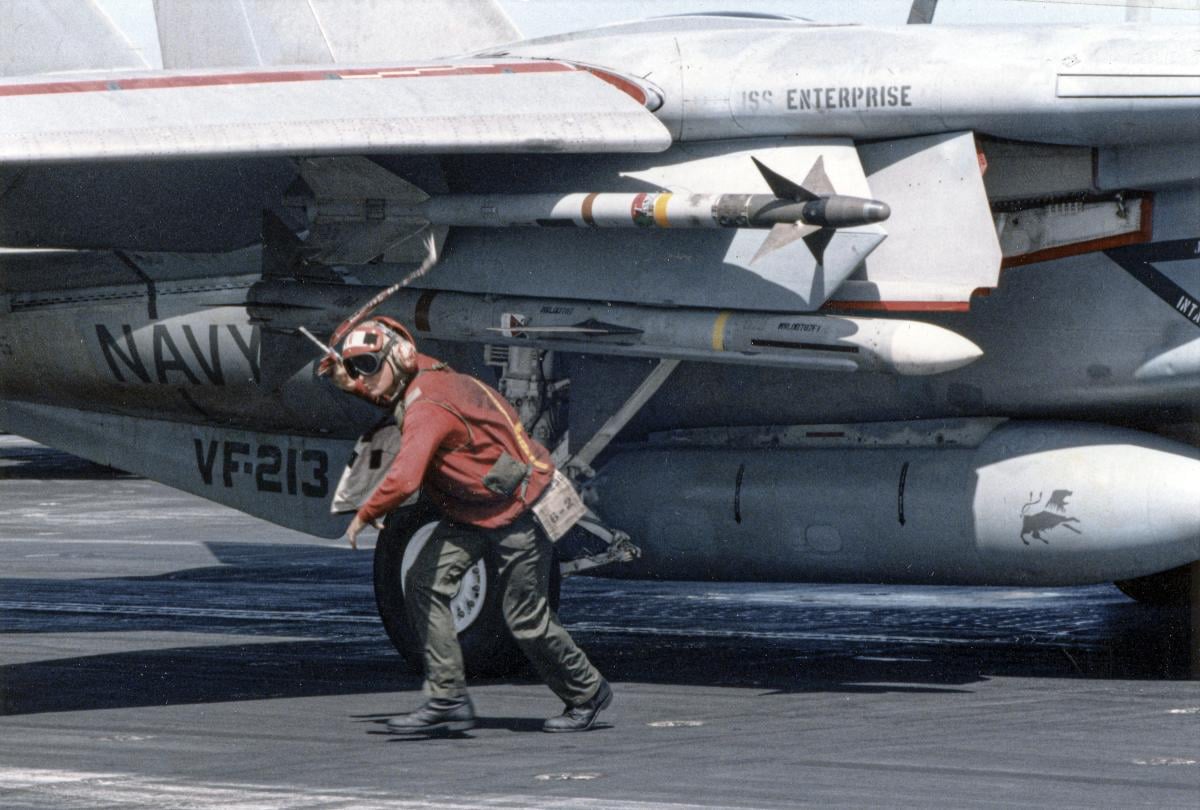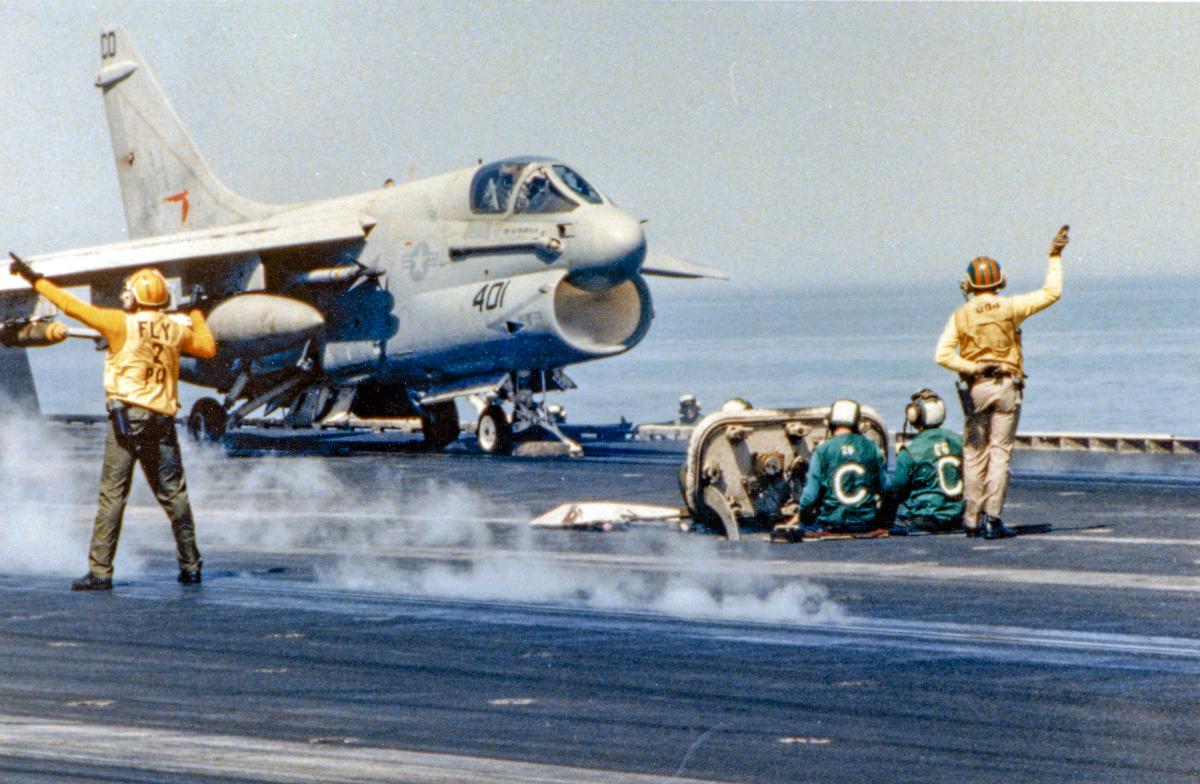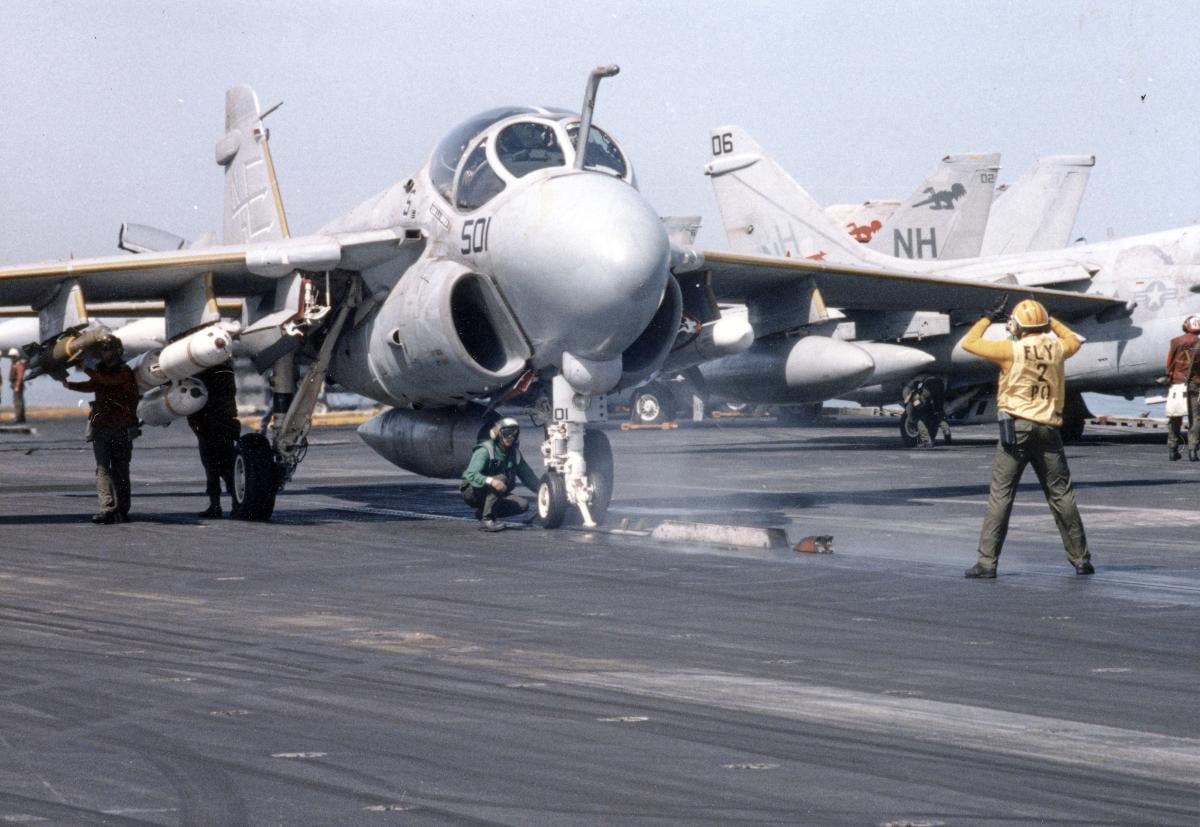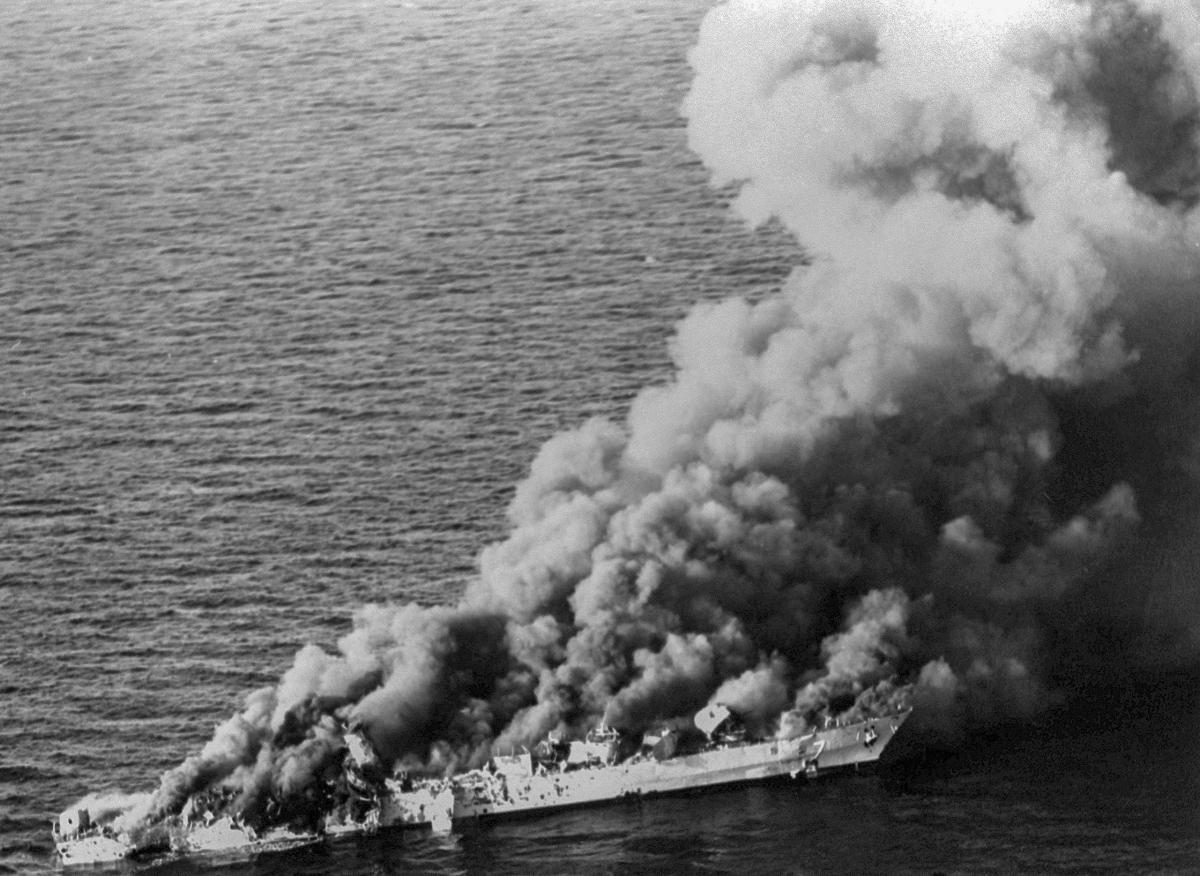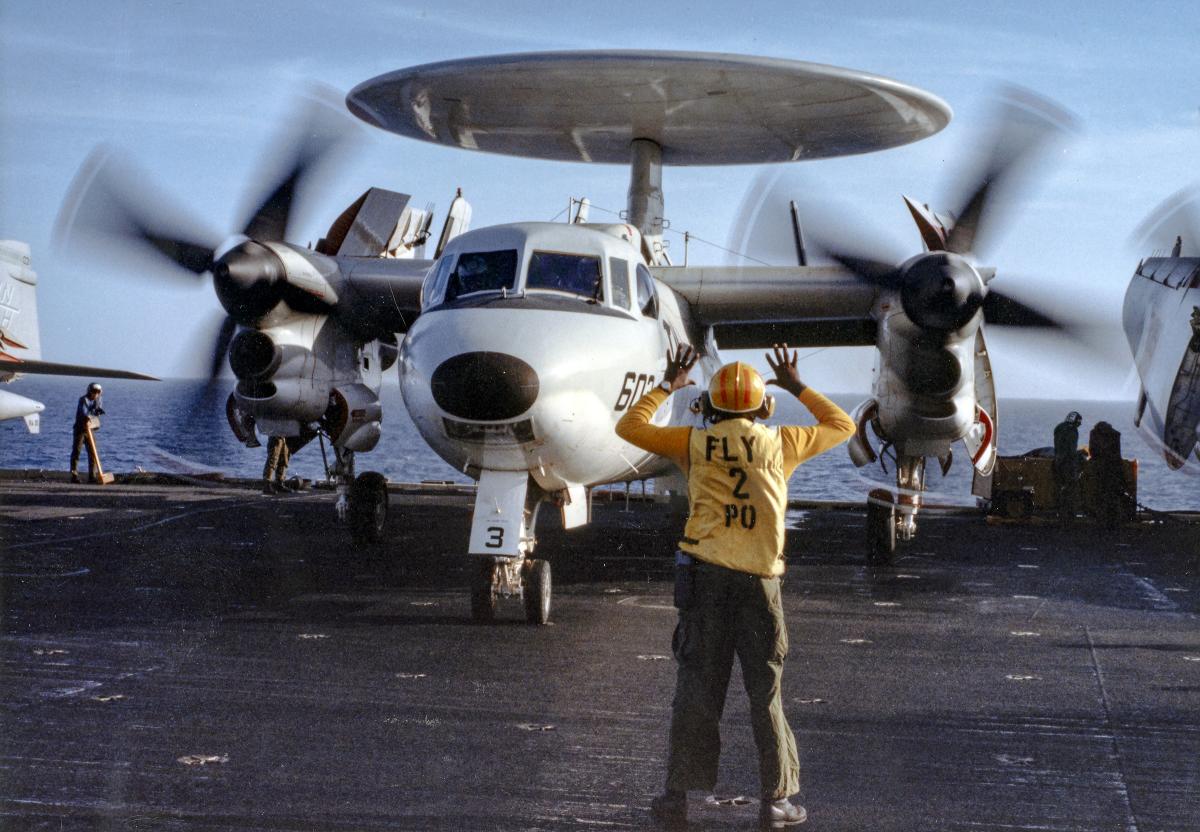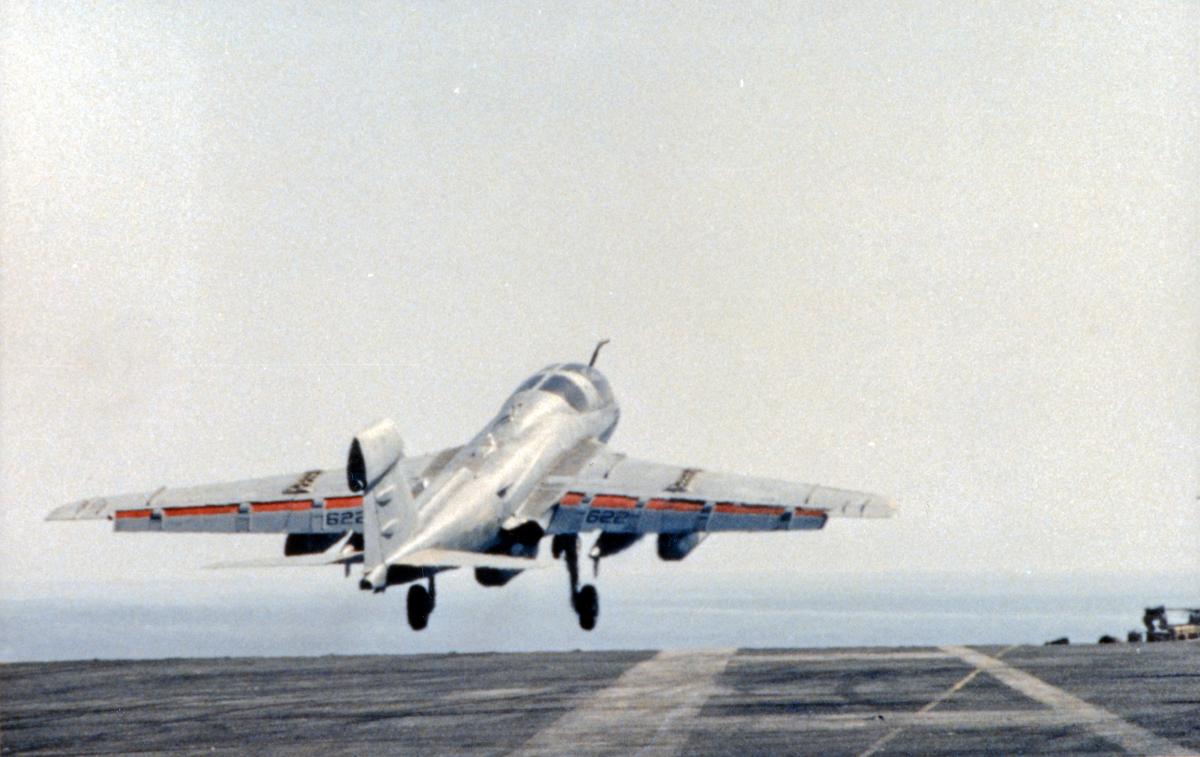On 14 April 1988, the USS Samuel B. Roberts (FFG-58) struck an Iranian mine in the central Persian Gulf. The explosion nearly forced the crew to abandon ship. No one was killed in the incident, but there were several injuries, some severe. The commanding officer reported that the force of the blast raised the Roberts's stem 10 to 12 feet. The fight to keep the ship afloat was a heroic effort. The substantial evidence linking Iran to the mining led the U. S. National Command Authority to respond appropriately on 18 April in an operation called Praying Mantis.
Battle Group Foxtrot, including the USS Enterprise (CVN-65), was positioned to handle just such a contingency in the northern Arabian Sea, approximately 200 nautical miles from the Strait of Hormuz. It had been conducting operations there for nearly two months in support of U. S. reflagged Kuwaiti tanker convoy operations.
Soon after news of the Roberts explosion, several of the battle group’s surface units sortied into the Persian Gulf to await further orders from Commander Joint Task Force Middle East (JTFME), Rear Admiral Anthony Less. Prior to Battle Group Foxtrot’s arrival in the northern Arabian Sea, tactical air (TacAir) contingencies had been tasked, planned, and approved by the Joint Chiefs of Staff. Immediately following the mining, the air wing modified its standardized contingency plans or developed new ones.
On board the Enterprise, Commander Carrier Air Wing Eleven received the Praying Mantis Operations Order (OpOrder) from Commander Cruiser Destroyer Group Three in the early evening of 17 April. The OpOrder tasked the air wing with attack and fighter combat air patrol (CAP) and a backup war-at-sea mission the next morning in support of the initial surface action against the Iranian oil platforms in the Persian Gulf and the sinking of a major Iranian naval combatant. Planning intensified.
By 0200 (local time) on 18 April, the direction and plans were firm, the air plan was in hard copy, and the strike leaders’ surface combat air patrol (SUCAP) support and war-at-sea strike plans were sent by message to JTFME. Selected aircrews were assigned either to participate in the initial fighter CAP/escort and attack SUCAP or to be part of a separate war-at-sea strike to locate and sink the Iranian frigate Sabalan, which had earned a reputation for her vicious attacks on neutral merchant shipping. The Intruders and Corsairs carried Harpoons, Walleyes, laser-guided bombs. Skippers, and Rockeyes. This gave them the diversity in weaponry to ensure an overwhelming seaworthiness kill against the Saam-class frigate.
After a few hours of restless sleep, aircrews arrived in their ready rooms, anticipating some activity from both Iranian air and surface units. The SUCAP and CAP/escort sorties—or SUCAP Group—consisted of four F-14 Tomcats, two A-6E Intruders, and two EA-6B Prowlers. The first SUCAP Group included fairly senior aircrews and was scheduled for six-and-one-half hours of flight time. To ensure that the war-at-sea strike was prepared to launch at daybreak, and that the SUCAP Group would arrive in time to support the surface action group (SAG) against the oil platforms, formal aircrew briefs began at 0430. The war-at-sea strike went into “alert 15” at 0630. The SUCAP Group launched at 0800 to be on station over the Strait of Hormuz at 0845.
Tanking en route provided fighter and attack aircraft with enough fuel to respond in the first hour after the shelling began. The U. S. Air Force routinely supported the battle group by placing a KC-10 airborne refueling station in proximity to the Strait of Hormuz. This allowed tremendous flexibility in all of the air wing’s operations. Carrying more than 100,000 pounds of fuel per aircraft to pass, the KC-10 allowed the air wing’s organic KA-6s and KA-7s to keep the SUCAP groups on station for a number of hours with a suitable “combat package” by shuttle-tanking. With this support, the SUCAP Group was positioned over the Strait of Hormuz, southwest of Bandar Abbas, Iran’s main naval air base in the southern Persian Gulf, ready to assist the surface forces in the Gulf.
The environmental conditions of the Strait of Hormuz and southern Persian Gulf are unique. April is the transition month that leads into the summer monsoon season. A dusty haze coats every surface, often forcing the aircraft to use instrument procedures to make daytime recoveries. During the summer monsoons, visibility consistently drops to less than one mile. Fortunately, the weather on 18 April was clearer, with horizontal visibility of approximately three to five miles. Positive identification of Iranian naval and air forces was crucial to the operation as allied and Soviet surface forces were in the area. Omani and United Arab Emirates patrol boats were also operating in the southern Persian Gulf, as well as Omani, United Arab Emirates, Iraqi, and Saudi Arabian aircraft.
The first SUCAP Group arrived on station south of Bandar Abbas at 0830 (local time). An E-2C Hawkeye early warning aircraft was positioned another 50 miles to the southeast, where its radar could still sweep the entire strait and the southern Persian Gulf. The E-2C was critical in maintaining the big picture for all airborne players and the battle group staff on board the Enterprise. The geographical shape of the southern Persian Gulf region and Iran’s territorial boundaries on the strait made it impossible for the F-14 CAP to provide 360° radar coverage when transiting the strait. Once the SUCAP Group committed to a surface contact, the F-14s would not be able to keep all Iranian fighters in their radar scan.
At 0855, radio warning calls were made in Farsi, French, and English to those on the Iranian oil platforms to abandon the platforms prior to imminent shelling. Dead silence followed the warnings, which left an eerie premonition of what was to come. Shelling of the Sirri and Sassan platforms commenced at precisely 0900.
Sirri and Sassan were chosen as targets because they both had been used for military purposes, including support for Iranian speedboat attacks on neutral shipping and support of mining operations in the Persian Gulf. After the initial shelling, the Iranians occupying the platforms—apparently convinced of the severity of the situation—quickly abandoned their resolve to stand and fight.
Within two hours of the initial shelling, one of the SUCAP A-6Es from VA-95 and two of the escort F-14 CAP aircraft from VF-114 proceeded through the strait in search of Iranian ships in the area, which were thought to be moving toward the U. S. warships to the west. A Saam frigate was believed to be hiding among two dozen merchant ships anchored southwest of Bandar Abbas. This TacAir surface surveillance group twice tried unsuccessfully to locate the frigate or any other potentially hostile Iranian vessels. Their lack of target confirmation precluded launching the war-at-sea strike. It was deduced later in the morning that the Saam frigates, the Sahand and Sabalan, were probably in port at Bandar Abbas.
During this time, the E-2C reported several Iranian F-4s airborne out of Bandar Abbas. The battle group’s F-14s were vectored on several occasions, but none came close enough to attempt an intercept with the F-4s. The F-4s seemed content to remain over land.
Four hours after the shelling began, one of Iran’s Combattante-II-class patrol boats, the Joshan, equipped with the Harpoon missile, moved toward the USS Wainwright (CG-28), Bagley (FF-1069), and Simpson (FFG-56). After an exchange of intentions on VHF channel 16, the Joshan refused to turn away. The Wainwright warned the Joshan of imminent attack. The Joshan then fired a Harpoon missile, which passed down the Wainwright’s port side, but failed to guide accurately. The Simpson launched an SM-1, which hit the Joshan. The Simpson and Wainwright proceeded to launch additional SM-ls, several of which scored direct hits. They continued the attack with five-inch and 76-mm. guns until they sank the Joshan.
Several hours lapsed while U. S. naval surface and air forces patrolled the Strait of Hormuz. Shortly after 1100, a U. S.-owned support vessel, the Willie Tide, had reported being attacked near the Saleh oil field. It was just past 1300 when Iranian Boghammer gunboats sortied from Abu Musa Island and attacked a U. S.-run and -manned oil rig in the Mubarak oil field off the coast of the United Arab Emirates. Iranian gunboats also attacked a United Kingdom merchant ship soon thereafter. Apparently, the Iranians anticipated the U. S. surface ships’ action against the Iranian platforms and initiated a preemptive attack with Boghammers to attack allied Gulf State oil platforms and support vessels. U. S. surface ships were not in position to challenge the attack. Therefore, two A-6s and one F-14 in the vicinity of Abu Musa Island were dispatched to counter the Boghammers attacking the Mubarak oil platforms.
The two A-6s were cleared to engage the Boghammers. The F-14 “held high’’ and provided CAP, while the A-6s dropped Rockeyes on the lead Boghammer. The loss of this boat was a strong deterrent. The other four boats fled back to Abu Musa Island and literally ran aground there. In the first air-to-surface encounter of the day, the A-6s were successful against a small, fast, highly maneuverable target.
At mid afternoon, the U. S. ships received information that indicated that Iranian naval ships in Bandar Abbas might be getting under way. The war-at-sea strike leader was launched to search for Iranian frigates in the Strait of
Hormuz. Proceeding to the vicinity of Larak Island with two F-14 escorts, the A-6 crew visually acquired a contact matching the description of an Iranian Saam-class frigate, moving at approximately 25 knots toward the southwestern area of the Persian Gulf.
The three U. S. planes remained close to the frigate, attempting to identify her positively by means of the A-6’s forward-looking infrared radar (FLIR) and the F-14’s onboard television camera system. Although the aircrews had 90% confidence of identifying the ship correctly, they needed a positive visual identification because of the large number of allied combatants in the vicinity. The A-6 came in at low altitude and high speed to identify the Sahand and immediately drew fire from the ship’s antiaircraft artillery (AAA) and infrared (IR) missiles. There was no mistaking the Sahand's intentions. Executing a “break-turn,” the A-6 crew discharged flares to defeat the missiles, then immediately retaliated, launching Harpoon, a laser-guided bomb (LGB), and Skipper weapons. The initial attack inflicted major damage on the Sahand and put her dead in the water, engulfed in flames.
The battle group commander had ordered the launch of the war-at-sea strike from the carrier on the initial identification. Six A-7s and one A-6, employing Walleye, Skipper, and 1,000-pound bombs, followed closely behind the initial attack. The strike group made successive attacks beginning with a second A-6 Harpoon attack that coincided with a Harpoon shot from the USS Joseph Strauss (DDG-16). All of the Harpoons, three of the Skippers, one Walleye, and several 1,000-pound bombs scored direct hits. The Sahand sank a few hours later.
The next day, in an Iranian interview, the captain of the Sahand spoke of firing on the A-6 as it attempted to identify his ship and said, “Though injured, we fought them to the last breath and the last bullet.” He testified that nine missiles had been fired at his ship.
The Iranian Air Force’s reaction to these events was minimal. Their F-4s flew several sorties but did not venture over the Persian Gulf long enough to present a threat to the escort F-14s. The Wainwright fired two SM-2 ERs at an Iranian F-4 track and scored a mission kill. The F-4E assets were either too valuable, or the Iranian Air Force believed it was in no position to support the Iranian Navy in its surface actions.
During the war-at-sea strike group’s attack on the Sahand, the SUCAP section of A-6s that had neutralized the Boghammer threat at the Mubarak oil platform was returning to the Strait of Hormuz after refueling from the KC-10. Shortly after their arrival, they were contacted by the E-2C and requested to contact the Strauss, which gave the flight an initial range and bearing for the possible location of another Saam-class Iranian frigate.
As the A-6s approached the area, the contact of interest began firing AAA. The A-6s used FLIR to identify the ship positively as an Iranian frigate, which was later discovered to be the Sabalan. The lead A-6 used a Mk-82, 500-pound LGB to stop the Sabalan dead in the water with a major hit down the stack to the engineering spaces. Even though the A-6 remained at a fairly high altitude, the aircrew noticed three IR surface-to-air missiles fired from the deck of the Sabalan during their delivery of the LGB. Within 20 minutes, additional A-6 aircraft with LGBs flew over the Sabalan, and the carrier had another war-at-sea strike en route. In the interim, higher authorities decided not to sink the Sabalan, which was ultimately towed into Bandar Abbas.
The war-at-sea strikes executed on 18 April were not a demonstration of sophisticated tactics against a formidable threat. Yet they clearly demonstrated the substantial force and capability of the U. S. Navy. The operation also served to validate readiness, verify attack profiles, and certify weapons reliability, accuracy, and damage effects.
The tactical success of the U. S. TacAir forces during Operation Praying Mantis can be specifically attributed to the success of the surface and air assets’ stand-off weapons and the air wing’s substantial training in weaponeering and delivery techniques. Although positive identification necessitated some risk, attack aircraft were able to minimize exposure to Iranian weapons envelopes by employing stand-off weapons, such as the “launch-and-leave” Harpoon and Walleye, both for suppression of enemy air defense hard-kill and mobility/firepower-kill tactics. Once the Iranian surface ship’s surface-to-air threat was defeated, the aircraft moved progressively closer with Skippers, LGBs, and iron bombs to achieve the seaworthiness-kill.
The opportunity for the U. S. Navy to participate in such an event is extremely rare. Since World War II, no navy has ever remotely challenged U. S. supremacy at sea. Therefore, we can learn some valuable lessons from Operation Praying Mantis—a few of which follow.
Fog of War: Combat operations create a surge of adrenaline, particularly for those involved in their first encounter. This will naturally produce some misinterpretation of enemy reaction and errors in situational awareness. Operation Praying Mantis was not immune to these kinds of mistakes. Few will admit to any serious errors, but a number of mistakes were made during the day’s events. Fortunately, most of the errors were minimized by the correlation and verification process of specialized U. S. assets and extremely well-disciplined warfare commanders, aircrews, and watchstanders who considered each action prior to employing a weapon; in most cases, they had very little time to make critical decisions.
Extensive evaluation of errors and deficiencies in the operation will occur, which is essential to achieve higher levels of readiness. However, the operation’s successful completion of virtually all of the Praying Mantis OpOrder objectives, while decisively defeating Iranian naval units, should not be lost in the dissection of tactics; command, control, and communications (C3); and those “other” items derived from its reconstruction. In addition, reconstruction should also analyze the things the crew were correct in omitting; the actions not taken during the operation may be more important than those that were executed.
Time Management: A battle group’s preparation and planning process will fill the entire time allotted to strike planning regardless of the time available. Planners have to assume they will not have much warning about when their forces will be employed. Last-minute detailed planning will force the crews involved, at least initially, to reach a state of fatigue in short order. If the combat extends over a fairly long time, particularly if the battle group remains on station for several days or weeks after the initial action, fatigue will become an important consideration.
Regardless of the time available to prepare for such an operation, aircrews are going to plan intensely into the late hours prior to anticipated combat operations. Few will get enough rest because they will be anticipating the coming events. Warfare commanders and aircrews are going to have to live with and plan for that factor in any extended operational situation. Realistic training must be devised to train safely for these tactical situations, so reduced aircrew performance remains at an adequate level to complete the mission successfully and survive.
Contingency Planning: Prior to arriving in the Indian Ocean, untold hours were spent planning and practicing coordination between the various warfare communities. Every air wing and battle group that deploys must submit a number of strike plans on various contingency taskings. As the events of 18 April unfolded, it was apparent that the unique contributions of both the aviation and surface communities were vital to the success of the operation. During the contingency response initiatives developed immediately after the Roberts was stricken, a number of attempts were made to mix aspects of separate contingency strike plans to devise a retaliatory attack. Forming rapid response plans this way—by combining separate strike plans for the sake of expediency—can jeopardize successful accomplishment of strike objectives.
During the actual events of 18 April, the operations could follow no specific prepublished outline. Instead, they relied upon the expertise and professional approach of each crew member in the execution of some broadly defined directions in the heat of battle.
Tactical Strike Organization: Air wings generally use a strike team organization that ensures most of the aircrew are exposed to contingency planning. The senior aircrew are assigned to lead the four to eight strike teams in the organization. Each of the senior “strike leaders” is also a division leader, tasked with the continual process of training his sections and divisions within a particular squadron’s tactical organization. It is not unusual, when real-world combat operations are imminent, for air wings to switch to a “first team” concept and assign senior combat veterans and more experienced aircrews. Such was the case with Operation Praying Mantis.
Whether to operate in the most critical phases of an operation with the established sections and divisions versus “stacking the deck” with senior, more experienced aircrew will always be a tough call. This decision should be made early in the preparation of any evolution, and explained to the crew members who are not chosen to participate initially. The advantages and disadvantages of both decisions are obvious. If the senior aircrew fly in the beginning of what is anticipated to be a short operation, the air wing commander may be left with “nugget-nugget” crews airborne during what could be the most intensive period of operations.
Composite Warfare Commander (CWC) Organization: Two years ago, the Navy inaugurated a new program to improve the war-fighting capability of its battle groups by upgrading the seniority and status of the carrier air wing commander (CAG) to a captain’s billet, assigning him as a subordinate commander working directly for the battle group commander as his strike warfare commander (STWC). This change reflects the inherent complexities of modem warfare and the requirement to employ a strike-tactics specialist with recent operational expertise to coordinate the battle group’s assets. The traditional commander CAG billet was retained and reassigned as the deputy air wing commander. In addition, air wing staff billets were upgraded in recognition of the new air wing’s role within the CWC structure.
Operation Praying Mantis was the first combat test of the new senior CAG arrangement. The positive results attained during this operation can be attributed largely to the air wing’s combat readiness and partly to the added benefits derived from the new division of responsibilities.
The new organization created noticeable differences during the planning stage of Operation Praying Mantis. Strike warfare requirements to optimize the air wing’s capabilities to succeed are, by the nature of carrier battle group operations, subject to a number of conflicting priorities and some compromises. In preparing for Operation Praying Mantis, the battle group staff, and many times the admiral himself, refereed these compromises. Under the old CAG organization, these decisions rarely would have risen above the carrier commanding officer level. Some believe the new organization may actually rely too much on the junior members of the flag staff to provide the key decision points for the admiral. During Operation Praying Mantis the new CAG organization enabled the air wing to cope with the problems associated with crisis management and organizational overload during both the planning and execution phases, while working a more highly integrated battle group under the complexities of a joint task force operation.
Intelligence Support: Intelligence support was critical to the entire evolution. The tactical situation was changing so rapidly that the crews launching from the carrier or manning combat centers had to receive the correct information on the Iranian order of battle. Each aircrew had to be thoroughly briefed on what had transpired since the initial shelling of the Iranian platforms, what Iranian assets were present in the Persian Gulf, where our own forces were located, and the positions of friendly and allied forces. The information flow among the U. S. surface forces in the Gulf, the air wing aircraft operating several hundred miles from the carrier, and the battle group in the Gulf of Oman had to be smooth and uninterrupted. Battle Group Foxtrot and the subordinate commanders’ real-time knowledge of combat actions and correct intelligence interpretations of actions transpiring in the Persian Gulf were essential to allow critical decisions to be made during the day’s events.
Rules of Engagement: During the months prior to the operation, the battle group trained to a specific set of rules of engagement (ROEs), termed “peacetime ROEs,’’ and specialized “Persian Gulf ROEs.” These rules were designed to be specific enough to prohibit mistakes in the employment of weapons systems but flexible enough to ensure that no U. S. force would be placed in a position from which they could not extricate or properly defend
themselves. The National Command Authority altered these rules of engagement to meet circumstances unique to the operations. Expecting an Iranian retaliation, the rules were changed to provide more flexibility in the use of surface and air assets, while ensuring that allied forces or neutral commercial traffic would not be jeopardized. In addition, the battle group commander provided more detailed aircrew ROEs, allowing the operating forces to more easily engage individual contacts after the shelling of the oil platforms.
The fighter airborne CAP ROEs are inherently more difficult to manage. Though a “weapons red and free” may be issued, it was still up to the crews involved in employing weapons systems to ensure that they did not mistake commercial air for an Iranian fighter. ROE updates were handled completely by the battle group commander over the UHF battle group command net and by carrier intelligence center intelligence officers in briefing crews prior to launch. The requirement to keep the airborne crews fully apprised of modifications to the ROEs and of the progression of events in the Gulf was not fully appreciated until midway through the day’s operations. This requirement was further exacerbated by eight-hour sorties made possible by KC-10 inflight refueling.
Considering that the ROEs had to be altered and that U. S. forces could not train for each specific situation that would arise during the events of the 18th, it is a tribute to the professionalism of the U. S. air and surface assets that the rules of engagement were employed so successfully and without an adverse incident to detract from the operation’s success.
Conclusion: Operation Praying Mantis constituted the first time since World War II that U. S. surface and air forces combined to thwart a country’s attempt to test the capabilities of our naval forces. The result reflected the emphasis the Reagan administration placed on the rejuvenation of the defense establishment, particularly the Navy, and the tactical renaissance in naval strike warfare that has occurred over the past few years. In the words of the Chief of Naval Operations, Admiral C. A. H. Trost: “We spent a lot of effort and taxpayers’ dollars the last seven years to achieve the level of readiness that we enjoy today. What our people saw was an opportunity for the first time under hostile conditions to use both their sensors and weapons; and they worked as advertised.”
Communications During the Operation
Communication among U. S. forces in the southern Persian Gulf, air wing aircraft, and the battle group in the Gulf of Oman was crucial to Operation Praying Mantis. Numerous command-and-control training exercises involving all battle group units had been conducted in the previous three months of deployment to simulate similar scenarios. This training proved invaluable, ensuring that air operations would remain flexible during the combat evolutions that were to follow. The E-2C Hawkeye aircraft from VAW-117 provided the crucial data-link and secure voice communications link between Battle Group Foxtrot on board the USS Enterprise (CVN-65) and the Joint Task Force Middle East Commander in the Persian Gulf, keeping all air and surface units apprised of the full scope of action.
Fortunately, on 18 April, the E-2Cs were able to provide this essential antiair warfare (AAW) coverage. The atmospheric conditions improved to the point where most of the contacts the E-2Cs detected were “high confidence” contacts. The ground-controlled intercept (GCI) of the Iranian Air Force appeared to be excellent. For example, on several occasions, when out of the F-14s’ radar scan, the Iranian F-4s turned to close a flight of A-6s and F-14s. The E-2C picked up the change in bogey course, alerted the ingressing or egressing SUCAP Group and, as soon as the F-14s turned back to put “nose-on,” the F-4s turned away to return or remain feet-dry. The F-4s’ closest point of approach to an F-14 was approximately 15 miles. Adrenaline was pumping when the F-14s turned nose-on to the threat. The F-4s never tested the Tomcats.
The value of the E-2C crews was proven repeatedly during operation Praying Mantis. The benefits of early warning to the air wing and the battle group, as the British learned in the Falklands Conflict, cannot be overstated.
The EA-6B Prowler aircraft from VAQ-135 were also critical to the operation’s success. They were tasked with providing jamming support and information concerning electronic emissions from the Iranians, which were often the first indication of Iranian intentions. The fighter and attack aircraft had a great deal of confidence in the EA-6Bs’ ability to shut down the Iranian GCI radars and communications, negate most surface-to-air threats, and define the Iranians’ potential course of action.
Although Iran has certainly suffered from a lack of adequate support for its aircraft and weapons systems over the past ten years, planners postulated the worst possible case in order to have substantial retaliatory capability following the shelling of the Iranian oil platforms. Consequently, though their weapons systems were suspect, the Iranian F-4s were assumed to have a full systems capability that could challenge the air wing with Sparrow and Sidewinder missiles. Tactics were therefore devised to counter a forward quarter-capable threat that would possibly challenge U. S. air superiority in the Persian Gulf.
The U. S. aircrews had a difficult time ascertaining the seriousness of the Iranian fighter threat at Bandar Abbas. They did not know how much experience the pilots in the south, at Bandar Abbas and Chah Bahar, had. Planning for the worst case, the aircrews assumed they were the best the Iranian Air Force had to offer. The crews stationed at Bandar Abbas and Chah Bahar allegedly were on a temporary respite from the Northern Front, and, therefore, had combat experience. Consequently, U. S. aircrews were not cavalier about their opponents’ competence.
—Captain Bud Langston, USN, and Lieutenant Commander Don Bringle, USN



